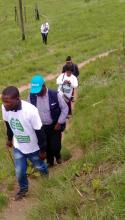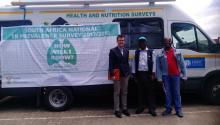South Africa conducts its first National TB Prevalence Survey 2017-2018
For several years South Africa’s National Department of Health (NDoH), has been planning to conduct its first National TB Prevalence Survey. The Survey aims to determine the true burden of TB disease through bacteriological assessment among the population aged 15 years and older. It will be implemented in 110 randomly selected clusters across the country and will consist of a sample size of 55 000 subjects. In partnership with the NDOH, the survey is being implemented by the South African Medical Research Council (SAMRC), the Human Sciences Research Council (HSRC) and the National Institute for Communicable Diseases (NICD) over a period of 24 months.
The WHO country office (WCO), in collaboration with WHO Headquarters (WHO HQ) has played a key role in the preparatory stages and implementation of the survey. This includes protocol and SOP development, resource mobilization, training and mentorship, as well as the coordination of partners.
The first pilot took place in November 2016 where operational and data challenges were identified by WHO. Through intensified support, communication between all the stakeholders improved, the data system was refined, retraining for field activities took place, additional survey staff were recruited, and the NDOH took ownership of the survey. Following a second pilot in July 2017, the survey was officially launched in August 2017 in Kwa-Zulu Natal.
Challenges are inevitable
As with most surveys, implementation has not been without challenges. The main challenge experienced in this survey’s first 9 clusters has been the low participation rate which averaged at 35%; way below the survey target of 85%.
To support NDOH’s National TB Programme in addressing this situation, WHO immediately provided technical support and leadership to address the challenges being experienced in the field and identify causes leading to the survey’s poor performance. In collaboration with WHO HQ and the NTP, WCO conducted an urgent field support mission in October 2017. The following implementation bottlenecks were identified, namely; suboptimal coordination of implementing partners; inadequate community mobilization resulting in low community participation; lack of incentives to encourage participation; and a limited survey budget which didn’t fully cover all field activities.
In response to recommendations made by WHO, the following interventions were implemented leading to a gradual increase in the participation rate:
- The NTP together with WCO, held an emergency planning meeting to formulate an intervention plan that would improve survey implementation.
- A Survey Management Team, consisting of the NTP and WCO was instituted by the NTP to improve leadership, governance and coordination challenges.
- WCO provided interim financial support to procure incentives for participants for the remaining 5 clusters for 2017, and in addition, 6 banners were procured to improve visibility of survey operations. Resources are currently being mobilized by the NTP to ensure sustainability of incentives.
- To improve visibility of survey operations in the community, WCO provided support for printing of 6 banners for the 3 teams.
- WHO conducted additional supportive supervision field missions to provide hands-on training and mentorship to the build capacity of survey field teams to improve survey operations
Remarkable improvement of survey operations achieved from the 10thcluster, soon after the interventions were implemented
The impact of WCO technical expertise support to NTP has improved the quality of survey field data collection activities. From cluster 10 to 16 the Participation rate has steadily improved to 70+ %. Though, the participation rate it is still below the survey target of 85%, the ongoing WHO support will continue to strengthen survey operations. Furthermore, the following results has been achieved; improved interaction and coordination of implementing survey partners resulting in the smooth running of field activities; improved adherence to survey field processes; improved community mobilization through engagement of community volunteers.
“If everyone is moving forward together, then success takes care of itself”
The survey has highlighted the importance of coordinated collaborative efforts of partners in order to achieve successful survey implementation. The roles and responsibilities that the NTP and each organization has, namely; HSRC, SAMRC and NICD, is of great importance and when efforts are in sync the results are visible. As a technical partner, WHO has played a key role in helping to coordinate efforts, build capacity and provide the required expertise and support in planning and implementing the survey.
WCO will continue providing ongoing technical support to NTP to develop an accelerated operational plan for 2018 to complete the field data collection on schedule in Nov 2018, to improve implementation, data quality and coordination of implementing partner activities and conduct a mid-term review of the survey in Q1 2018.


